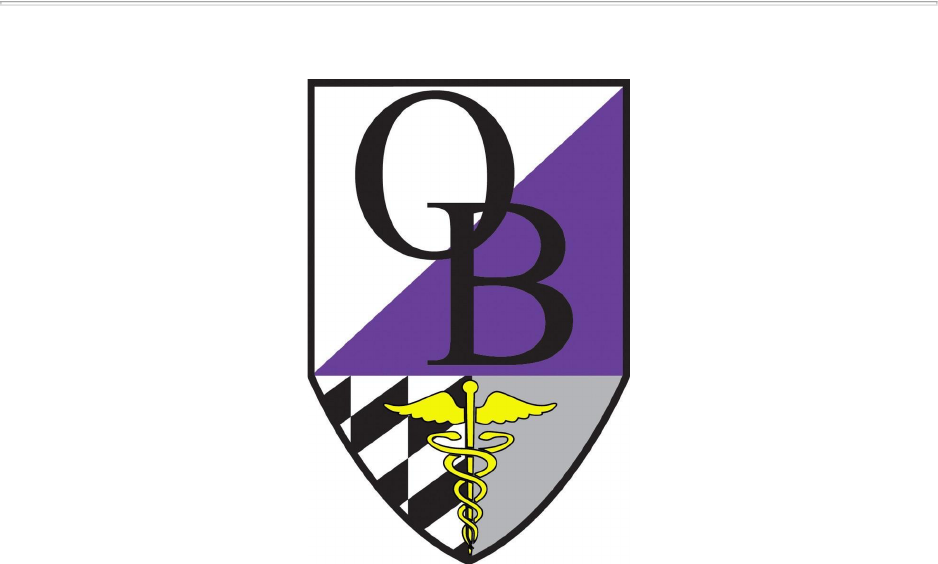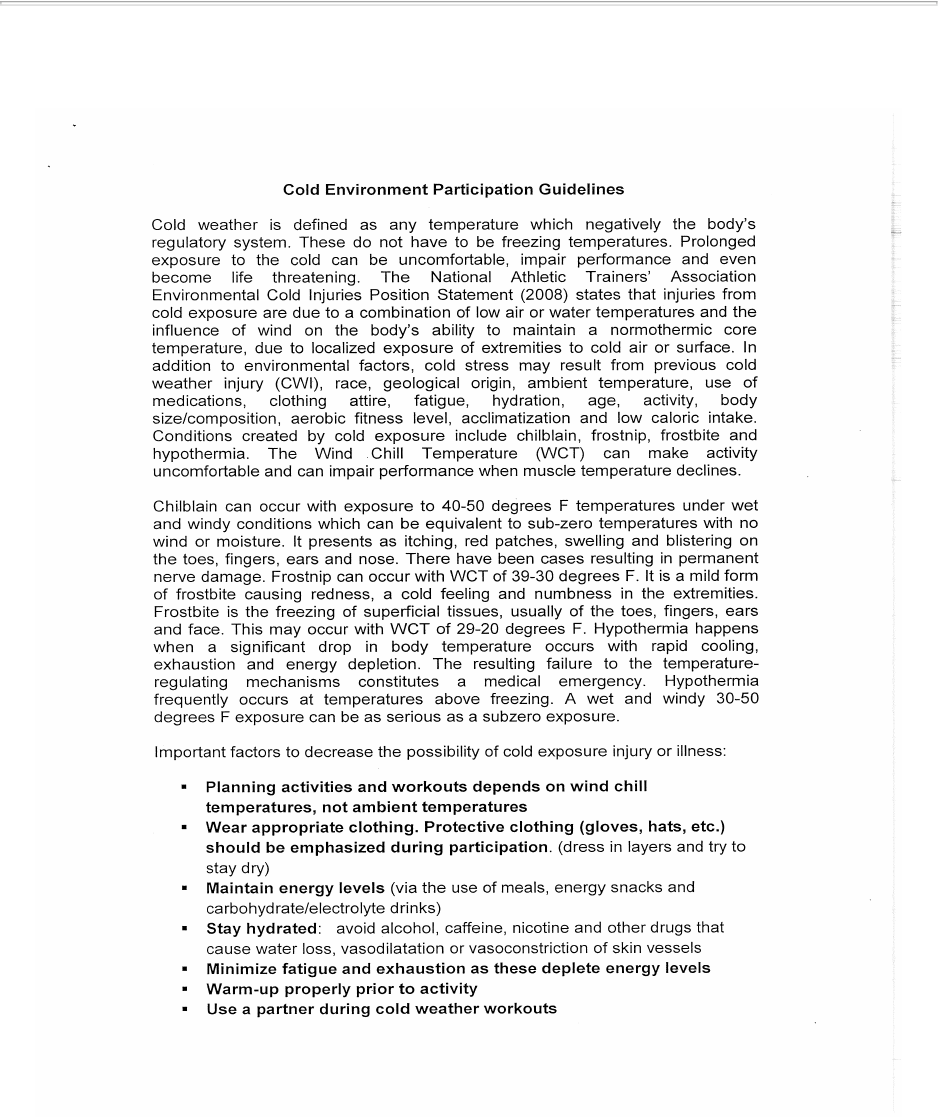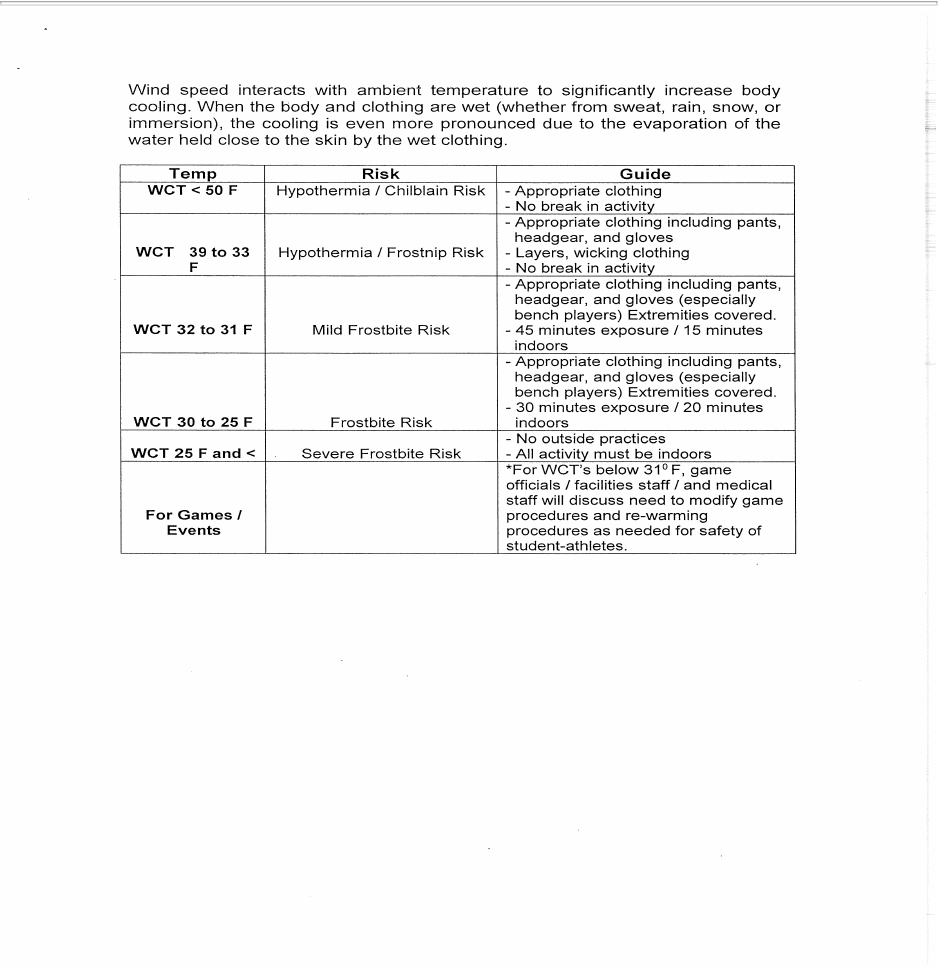
Old Bridge High School Athletic Training
Ralph Di Iorio, ATC/PT Stephen La Regina, ATC Jane Maline, ATC
Collin Mascola, ATC
Revised June 2019
1
Old Bridge High School Sports Medicine Policies and Procedures
Mission Statement: To ensure the safety and well-being for our student athletes and to provide
the most current standards and best practice when caring for specific medical conditions.
Objectives: To minimize the risk due to an injury that may occur as a result of participation during
school sponsored events.
To provide guidance to Old Bridge High School Athletic Department employees in managing
specific medical conditions, based on these policies and procedures and the emergency action
plan.
By following current legal standards and law, in compliance with appropriate BOE policy, with
guidance from state governing bodies (NJSIAA, NFHS) and position statements from various
sports medicine bodies (NATA).

Old Bridge High School Athletic Training
Ralph Di Iorio, ATC/PT Stephen La Regina, ATC Jane Maline, ATC
Collin Mascola, ATC
Revised June 2019
2
Policy……………………………………………………..…………………….…………………Page
Roles and Responsibilities……………………………………………………………………………………………...3
Athletic Management Responsibilities…………………………….……………………………….…………...4
Heat Acclimation……………………………………………………………………………………….……………..…..6
Heat Emergency…………………………………………………………………………………………………………….7
Cold Weather Participation……………………………………………………………………………………….….8
Weather Emergency……………………………………………………………………………………………………10
Blood Exposure……………………………………………………………………………………………………………10
Cardiac Emergency………………………………………………………………………………………………………10
Head/Spine Injuries……………………………….…………………………………………………………………….10
Musculosketal Injury Emergencies…………………………………….…………………………………………11
Ocular Injures………………………………………………………………………………………………………………11
Dental/Oral Injures………………………………………………………………………………………………………11
Medical Conditions………………………………………………………………………………………………………12
Asthma
Anaphylactic Reaction
Sickle Cell
Blood Disorders
Diabetes
Hyperglycemic
Hypoglycemic
Cardiac Conditions
Seizures
Skin Disease
Disordered Eating
Opioid/Drug Education…………………………………………………………………………………………………13
Narcan………………………………………………………………………………………………………………………….14
Index…………………………………………………………………………………………………………………………...14

Old Bridge High School Athletic Training
Ralph Di Iorio, ATC/PT Stephen La Regina, ATC Jane Maline, ATC
Collin Mascola, ATC
Revised June 2019
3
Roles and Responsibilities
All students must have:
à Current/passed physical – A physical must be cleared by the school physician, as required
by state law, prior to participation.
à A physical is good for 365 days, from the actual date of the exam.
à A physical must be current on their first day of official practice (NJSIAA sanctioned start
date or after), for the current season.
à Academically eligible to participate.
DUE DATES FOR PRIVATE PHYSICALS.
Fall sports season: July 15
th
, 2019
Winter sports season: October 1
st
, 2019
Spring sports season: February 1
st
, 2020
ANY PHYSICALS HANDED IN AFTER THESE DATES MAY NOT BE CLEARED IN TIME FOR
TRYOUTS.
Coaches must have:
à Current coaching credentials required by state/NJSIAA/NFHS
o Principles of coaching
o First aid/CPR
o Heat acclimation
o Concussion Awareness Training
It is the coach’s responsibility to:
à Ensure that all students on their team/roster have the required paperwork completed
and acknowledged. Will collect and maintain Emergency contact cards and hand Health
History and roster in to the Athletic Trainer/Athletic Director in timely fashion.
à Supervise all athletes prior to, during and after practices/events as per appropriate BOE
Policies.
à Report/refer any injuries and communicate with the athletic trainer when injuries occur
at away/off campus events.
à Under no circumstances should a coach collect/hold any medical document, including
physicals.
à In the advent of injury during summer practices, the coach is responsible to document
(accident report and school insurance form) and refer for medical evaluation as needed.
*Note: School policy and adherence to New Jersey laws should be followed in relation to any
violence, harassment, bulling, intimidation, suspected drug use or any mental health issues.

Old Bridge High School Athletic Training
Ralph Di Iorio, ATC/PT Stephen La Regina, ATC Jane Maline, ATC
Collin Mascola, ATC
Revised June 2019
4
Athletic Management Responsibilities
The school physician or specified delegate (i.e. Sports Medicine Fellow) will be responsible:
à Review and approve all sports physicals
à To request additional documentation (if necessary) to clear a physical
à To restrict participation due to any medical condition
à To have final say over all return to play decisions
à To review standing orders on an annual basis
à To evaluate ALL concussions for return to play in athletics (Rutgers Sports Medicine
Fellow)
Note: School physician has final say on a student athlete’s participation. They may, in some
circumstances, require additional protective equipment to be worn by the athlete at their own
expense.
The Athletic Trainer will be responsible:
à To provide coverage for events and practices after school
à To determine, with co-ordination from the athletic director, the risk involved as to the
level of coverage necessary.
o In the event of multiple locations or non-traditional practice times, the coach must
report any injuries that require further evaluation or treatment to the athletic
trainer, if they are not present.
à To evaluate, treat and refer (if necessary) as per state license, school policy
à Working under the direction of the school physician or referring physician.
à Communicate with each coach, as indicated, any specific medical conditions and
participation status
à Keep accurate records of referrals, treatments, accident reports and provide school
insurance forms as needed for injuries sustained during Old Bridge BOE approved
activities.
à Returning the student athlete to activity shall be determined by athletic trainer as per
school physician or any referring physician after proper evaluation and treatment.
The Coach will be responsible:
à To ensure all student athletes have current and passed physical (Realtime list)
à Have A PARENT sign up and acknowledge all forms for Athletic Participation
à Collect health history updates – To be handed in to athletic trainer
à Collect all emergency cards – NEEDED FOR ATHLETE TO TRAVEL WITH TEAM
à To ensure all athletes are wearing properly fitted protective equipment required for
participation.

Old Bridge High School Athletic Training
Ralph Di Iorio, ATC/PT Stephen La Regina, ATC Jane Maline, ATC
Collin Mascola, ATC
Revised June 2019
5
o THIS INCLUDES ANY ADDITIONAL EQUIPMENT DEEMED I BY SPORTS MEDICINE
STAFF/HEALTH CARE PROVIDER (i.e. protective eye wear, bracing, ect.)
o Note: Coaches should never collect/hold onto medical documents (physicals or
medical notes for restrictions or return to play). Students should be instructed to
hand them to athletic trainer or nurse.
The Parent/Student Athlete will be responsible:
à Ensure physical is current and passed
à Acknowledge all on line forms and sign up MUST BE DONE BY PARENT
à Report any injuries or medical conditions the require medical health care providers
services to the athletic trainer
DUE DATES FOR PRIVATE PHYSICALS.
Fall sports season: July 15
th
, 2019
Winter sports season: October 1
st
, 2019
Spring sports season: February 1
st
, 2020
ANY PHYSICALS HANDED IN AFTER THESE DATES MAY NOT BE CLEARED IN TIME FOR
TRYOUTS.

Old Bridge High School Athletic Training
Ralph Di Iorio, ATC/PT Stephen La Regina, ATC Jane Maline, ATC
Collin Mascola, ATC
Revised June 2019
6
Heat Acclimation
NEW JERSEY STATE INTERSCHOLASTIC ATHLETIC ASSOCIATION 1161 Route
130 North, P. O. Box 487 Robbinsville, NJ 08691
Pre-season Heat-Acclimatization Guidelines
Intent: To provide pre-season acclimatization guidelines prior to the season for student athletes
with the purpose of minimizing injury and enhancing the player’s health, performance, and well-
being.
Core Principles:
1. Acclimatization Period: The first five days of Board of Education approved practice will
consist of no more than three (3) hours of practice time. For Field Hockey and football,
helmets may be worn on the first two days. Beginning on the third (3
rd
) day, full
protective gear may be added.
2. Scrimmages: A student/athlete shall not be permitted to participate in a scrimmage until
he/she has completed six (6) days of practice for all sports.
3. Rest Period: Teams may not practice for more than six (6) consecutive days. One 24
hour rest period must be included within a seven (7) day period.
4. 3 – 5 Practice Rule: The maximum allotted time per day for practice is 5 hours. A 5 hour
practice day may not be followed by a practice day greater than 3 hours; therefore,
practice days may follow a 3-5-3-5 format.
5. Recovery Period: A minimum of a three (3) hour recovery period should be provided
after any session of greater than 2 hours in length and a three (3) hour recovery period
should be provided before a walk-through.
6. Practice Prior to Approved Date: In football, it is recommended that schools should not
allow the use of full equipment for school sponsored practices prior to the NJSIAA official
start of practice date. Reminder: The wearing of equipment and/or exercise during hot
weather increases the risk of heat injury or illness.
Definitions:
Practice – the time a player engages in physical activity. It is recommended that any practice
session be no greater than three (3) hours in length. Warm-up, stretching, conditioning, weight
training and ‘cool-down’ periods are all considered practice. Note: Practice sessions may be
divided while adhering to the time restrictions as described above in #4.
Example: 3 Hour Day: one 3 hr practice, or two 1-1/2 hr practices 5 Hour Day: one 3 hr practice
and one 2 hr practice or
one 2-1/2 hr practice and one 2-1/2 hr practice Walk-through – No protective equipment or
strenuous activity permitted.
Only balls and field markers (cones) may be used.

Old Bridge High School Athletic Training
Ralph Di Iorio, ATC/PT Stephen La Regina, ATC Jane Maline, ATC
Collin Mascola, ATC
Revised June 2019
7
www.zunis.org: Visit this web site for further information on heat injury/illness as it pertains to
the adjustment of practice times.
Heat Emergency
The management of heat related injuries involves recognition and access to rapid cooling (cold
water emersion). Using the heat index and restricting participation based upon these
measurements is an essential part in prevention of heat related injuries. The guidelines are as
follows:
WBGT (F) Heat Index
Less than 80 Less than 80
Very low risk. No restrictions Activity to rest 30/5
NJ - recommends same and 3 breaks/hour min 3 minutes each.
80-84.9 80-90
Low risk. Normal activity monitor athletes activity/rest 25/5
NJ - recommends same and 3 breaks/hour min 4 minutes each
85-87.9 91-103
Moderate risk. New or unconditioned athletes should not practice. Frequent breaks for
hydration and monitor all athletes activity/rest 20/5. Immersion pool on site if needed.
NJ - recommends Max 2 hours practice no equipment (football/field hockey goalies) and 4
breaks/hour min 4 minutes each
88-89.9 104-124
High risk. All athletes supervised, no equipment to be used activity/rest 15/5. Immersion pool
on site if needed.
NJ - recommends Max 1 hour practice no equipment and 20 minutes rest/hour
90 and over. 125 and over
Suspend activity!
There should be access to water and ice on the field and use a stop watch or your cell phone to
keep a schedule and FOLLOW IT! If an athlete is in distress, dial 911. If available begin cooling
the athlete immediately.
Equipment is available to assess the field temperatures (wet bulb measurement) and cooling
tubs for rapid cooling, in the event of a heat related illness.
All coaches must know the temperature and have the index of their location at the time of
practice and chit is hourly and adhere to the above guidelines. (There are apps available to
download to your smart phone)

Old Bridge High School Athletic Training
Ralph Di Iorio, ATC/PT Stephen La Regina, ATC Jane Maline, ATC
Collin Mascola, ATC
Revised June 2019
8
Cold Weather Participation
As per NJSIAA recommendations to mitigate the risk of hypothermia and Frostbite:

Old Bridge High School Athletic Training
Ralph Di Iorio, ATC/PT Stephen La Regina, ATC Jane Maline, ATC
Collin Mascola, ATC
Revised June 2019
9
All coaches must know the Temperature and wind chill of their location at the time of practice
and check it hourly. They must adhere to the above guidelines.

Old Bridge High School Athletic Training
Ralph Di Iorio, ATC/PT Stephen La Regina, ATC Jane Maline, ATC
Collin Mascola, ATC
Revised June 2019
10
Weather Emergencies
In the event of inclement weather, it is important to seek shelter in the nearest building or your
vehicle, if it is safe to do so. These conditions may include Lightening, wind events and heavy
rain/hail.
Note: Check the emergency action plan for the venue specific shelter locations.
NJSIAA recommends that in the termination/suspension of a game or event if the threat of an
electrical storm is imminent. This means the sight or sound of thunder. The site should be
evacuated, all individuals seek shelter and the event will be suspended for 30 minutes from the
last incidence (sight or sound of thunder). The resumption of activity will be decided by the
officials and the sight supervisor/administrator.
Blood Exposure
Training is provided to all district staff members for exposure to blood borne pathogens and
adherence to the use of universal precautions is necessary for the prevention of unnecessary
spread of disease.
Cardiac Emergency
It is recognized by the NJ Department of Education that cardiac emergencies can happen while
participating in sport or from a preexisting medical condition. In the event of a cardiac
emergency, 911 should be initiated immediately and an AED should be available at all school
sponsored events. AED’s are located at various locations throughout the district and there are 5
travel AED’s. These are noted in the emergency action plan.
Head/Spine Injuries
All suspected spine injuries are to be referred by EMS for evaluation. All head/spine injuries are
to be managed in accordance with current guidelines as per physician standing orders.
The New Jersey Department of Education recognizes concussions as a risk in sport that needs
proper recognition and management. A concussion is a type of traumatic brain injury (TBI) that
involves both physical and cognitive deficits. Symptoms can range from mild to severe. An
athlete suspected of a concussion must be evaluated before returning to play. If an athlete is
held out of activity because of a suspected concussion, they must be evaluated by the school
physician (even if they have been evaluated by a private physician). Athlete’s participating in a
sport, for old bridge, must to follow the return to play guidelines as per school policy in

Old Bridge High School Athletic Training
Ralph Di Iorio, ATC/PT Stephen La Regina, ATC Jane Maline, ATC
Collin Mascola, ATC
Revised June 2019
11
accordance with current medical recommendations. This may include academic
accommodations, as recommended by school or private physician. The return to play is as
follows:
• Step 1: Completion of a full day of normal cognitive activities (school day, studying for
tests, watching practice, interacting with peers) without reemergence of any signs or
symptoms. If no return of symptoms, next day advance.
• Step 2: Light Aerobic exercise, which includes walking, swimming, and stationary cycling,
keeping the intensity below 70% maximum heart rate. No resistance training. The
objective of this step is increased heart rate.
• Step 3: Sport-specific exercise including skating, and/or running: no head impact
activities. The objective of this step is to add movement.
• Step 4: Non-contact training drills (e.g. passing drills). Student-athlete may initiate
resistance training.
• Step 5: Following medical clearance (consultation between school health care personnel
and student-athlete’s physician), participation in normal training activities. The objective
of this step is to restore confidence and assess functional skills by coaching and medical
staff.
• Step 6: Return to play involving normal exertion or game activity.
Note: The above may be modified at the discretion of the school physician on an individual
basis.
Musculoskeletal Injury Emergencies
Musculoskeletal injuries, on rare occasions, can lead to threat of life or limb and should be
properly treated as per physician standing orders. If any significant injury is suspected the
evaluation and care should be provided by the highest level of care available. The chain of
command is listed in the Emergency Action Plan. These include the following, but not limited
to: Sprains, Strains, Dislocations, Fractures and wound care.
Ocular Injuries
The New Jersey Department of Education recognizes that ocular injuries are a risk with sports
Ocular injuries can result from sport and can be serious, including the loss of sight. There are
circumstances that an athlete may be required to wear protective eyewear and must be
enforced at all times when participating.
Dental Injuries

Old Bridge High School Athletic Training
Ralph Di Iorio, ATC/PT Stephen La Regina, ATC Jane Maline, ATC
Collin Mascola, ATC
Revised June 2019
12
Injuries to the teeth can be prevented/minimized with mouthguards. In the advent of dental
injury, the athlete should be referred to a dentist for treatment. If a tooth is broken or knocked
out, every effort should be taken to save the dislodged piece and given to the individual to take
with them for immediate treatment. The athletic trainers carry save-a-tooth or the piece can be
preserved in their own saliva.
Medical Conditions
The following is a list of medical conditions that may require special instructions for
participation limitations and/or a plan of care provided by a treating physician. It is the
responsibility of both the affected individual, parents, coaches and the medical staff to
maintain communication and follow the instructions, as put forward by the appropriate medical
personnel. These conditions include (but are not limited to):
o Asthma
o Anaphylactic Reaction
o EpiPen use
o Sickle Cell/Exertional Sickling
o Blood Disorders
o Diabetes
o Hyperglycemic
o Hypoglycemic
o Cardiac Conditions
o Seizure Disorder
o Skin Disease
o Eating disorders
Any of these conditions can lead to life altering consequences. If at any time these conditions
progress to potentially life threatening, 911 should be called immediately.

Old Bridge High School Athletic Training
Ralph Di Iorio, ATC/PT Stephen La Regina, ATC Jane Maline, ATC
Collin Mascola, ATC
Revised June 2019
13
Opioid/Drug Education
Both the NJSIAA and the New Jersey Department of Education provide information on the
use/misuse of Opioids (and other drugs), that can lead to addiction. Any individual suspected of
misusing prescription medication (or other drugs) should be referred to the proper medical
staff for evaluation. Administration must be notified and BOE policy followed in all
circumstances.
The NJSIAA also provides a list of banned substances that athletes may be (randomly) tested for
at state final competitions.
Narcan
The administration of Narcan by a school nurse or other trained employee to anyone on school
grounds is allowed as per school policy, pursuant to state law.

Old Bridge High School Athletic Training
Ralph Di Iorio, ATC/PT Stephen La Regina, ATC Jane Maline, ATC
Collin Mascola, ATC
Revised June 2019
14
Index
A
Anaphylactic reaction P. 12
EpiPen: BOE policy: Administration of Medicine 5330
Asthma P. 12
BOE Policy: Administration of Medicine 5330 Treatment for Asthma 5345
NATA: Management of Asthma:
https://www.nata.org/sites/default/files/mgmtofasthmainathletes.pdf
B
Blood exposure P. 10
Universal Precautions/school policy blood borne pathogen training
Bulling P. 3
BOE policy: Harassment, Intimidating, Bullying 5312 Dating Violence 5519 Sexual
Harassment 5751
C
Cardiac Emergency P. 10,12
CPR BOE Policy Do Not resuscitate Order 5332
AED BOE Policy: Use of Defibrillators 5300
NJ Department of Ed Sudden Cardiac Death Warning:
https://www.state.nj.us/education/students/safety/health/services/cardiac.pdf
Cold water immersion: P. 7
http://forums.njsiaa.org/uploads/FileUpload/46/23eb91bd36cb213ace2c2c9c267358.p
df
Cold weather participation P. 8
NJSIAA Recommendations: Cold environment participation
https://www.njsiaa.org/documents/cold-environment-participation-guidelines
NFHS Recommendations: https://www.nfhs.org/articles/guidelines-for-competition-in-
the-cold/
NATA Position Statement: https://athletictherapy.org/media/1040/nata-position-
statement-environmental-cold-injuries.pdf
D
Dental/Oral Injuries P. 11
NATA Position Statement: http://natajournals.org/doi/pdf/10.4085/1062-6050-51.8.01
Diabetes P. 12
BOE Policy: Administration of Medicine 5330 Diabetes Management 5335

Old Bridge High School Athletic Training
Ralph Di Iorio, ATC/PT Stephen La Regina, ATC Jane Maline, ATC
Collin Mascola, ATC
Revised June 2019
15
NATA Position statement of Type 1 Diabetes:
https://www.nata.org/sites/default/files/mgmtofathletewithtype1diabetesmellitus.pdf
Disordered Eating P. 12
NATA Statement: http://natajournals.org/doi/pdf/10.4085/1062-6050-43.1.80
Drug education P. 13
BOE Policy: NJSIAA Random Testing Interschool Athletics 2435
BOE policy: Opioid Overdose Prevention 5301 Substance Abuse 5530 Therapeutic
Programs Drugs and Alcohol 5331 Student Smoking 5533
E
EpiPen: BOE policy: Administration of Medicine 5330 P. 12
Exertional Heat Illness: http://natajournals.org/doi/pdf/10.4085/1062-6050-50.9.07
Exertional Sickling: https://www.nata.org/sites/default/files/sicklecelltraitandtheathlete.pdf
H
Harassment and Bulling P. 3
BOE policy: Harassment, Intimidating, Bullying 5312 Dating Violence 5519 Sexual
Harassment 5751
Head Injuries P. 10
BOE Policy: 2431.4 Concussion Prevention and Treatment
NJSIAA statement:
http://forums.njsiaa.org/uploads/FileUpload/d1/841f9f04d19faadc2bc5e6aa5098cd.pdf
NATA Positions Statement Concussion Management:
http://natajournals.org/doi/pdf/10.4085/1062-6050-49.1.07
NATA Management of Sport Concussion:
https://www.nata.org/sites/default/files/mgmtofsportrelatedconcussion.pdf
Current Guidelines as per Berlin Conference Consensus Statement (2016):
https://bjsm.bmj.com/content/early/2017/04/26/bjsports-2017-097699
Heat acclimation: P. 6
BOE Policy Heat Acclimation 3431.3
Heat illness NJSIAA POLICY:
http://forums.njsiaa.org/uploads/FileUpload/da/af858051aae09d8a170bc15d3a76ee.p
df
NFHS Dangers of Heat Illness: https://www.nfhs.org/articles/dangers-of-heat-illness-
reduced-by-following-proper-guidelines/
NATA Position Statements: Heat Acclimation:
http://natajournals.org/doi/pdf/10.4085/1062-6050-44.3.332
Exertional Heat Illness: http://natajournals.org/doi/pdf/10.4085/1062-6050-50.9.07
Heat Treatment Consent: https://www.nata.org/sites/default/files/heat-stroke-
treatment-authorization-form_0.pdf

Old Bridge High School Athletic Training
Ralph Di Iorio, ATC/PT Stephen La Regina, ATC Jane Maline, ATC
Collin Mascola, ATC
Revised June 2019
16
Cold water immersion:
http://forums.njsiaa.org/uploads/FileUpload/46/23eb91bd36cb213ace2c2c9c267358.p
df
Heat Participation:
http://forums.njsiaa.org/uploads/FileUpload/c8/54d8bf9ca4d54953bc9e6217b609ce.pd
f
NATA Positions statement Fluid Replacement:
https://www.nata.org/sites/default/files/fluid_replacement_for_the_physically_active.
pdf
Hyperglycemic P. 12
Hypoglycemic P. 12
M
Mental Health issues P. 3
BOE policy: Physical Restraint and Seclusion 2469 Student Suicide Prevention 5350
Musculoskeletal Injuries: P. 11
(Sprains, Strain, Dislocation, Fracture, Wound care)
N
Narcan P. 13
BOE policy: Opioid Overdose Prevention 5301 Administration of Medication 5330
New Jersey Overdose Prevention Act, P.L. 2013, c. 46.
O
Ocular Injuries P. 11
NJ Department of Education Eye Injury Fact Sheet:
https://www.state.nj.us/education/students/safety/health/SportsRelatedEyeInjury.pdf
Opioid/Drug education P. 13
NJ Opioid Fact Sheet:
https://www.nj.gov/education/students/safety/behavior/atd/opioid/FactSheet.pdf
BOE Policy: NJSIAA Random Testing Interschool Athletics 2435
BOE policy: Opioid Overdose Prevention 5301 Substance Abuse 5530 Therapeutic
Programs Drugs and Alcohol 5331 Student Smoking 5533
P
Participation P. 3
BOE Policy: Co-Curricular Activities 2430 Athletic Competition 2431
NJSIAA recommendations:
http://forums.njsiaa.org/uploads/FileUpload/48/11641761acafbd32d283e920a7a678.p
df
BOE policy: Liability for pupil welfare 3280 Code of Ethics 3211 Electronic
communication w students 3283 Use of personal cell phone 3322

Old Bridge High School Athletic Training
Ralph Di Iorio, ATC/PT Stephen La Regina, ATC Jane Maline, ATC
Collin Mascola, ATC
Revised June 2019
17
Facilities use: Maintenance and Repair 7410 Care of Equipment 7411 School Safety 7430
Use of Facilities 7510
S
Seizures P. 12
BOE Policy: Administration of Medicine 5330
Sickle Cell P. 12
Skin Disease
NATA: Skin Disease: http://natajournals.org/doi/pdf/10.4085/1062-6050-45.4.411
Spine Injuries P. 10
NATA Statement: Acute management C-Spine:
http://natajournals.org/doi/pdf/10.4085/1062-6050-44.3.306
Supervision/Participation P. 3
BOE Policy: Co-Curricular Activities 2430 Athletic Competition 2431
NJSIAA recommendations:
http://forums.njsiaa.org/uploads/FileUpload/48/11641761acafbd32d283e920a7a678.p
df
BOE policy: Liability for pupil welfare 3280 Code of Ethics 3211 Electronic
communication w students 3283 Use of personal cell phone 3322
Facilities use: Maintenance and Repair 7410 Care of Equipment 7411 School Safety 7430
Use of Facilities 7510
V
Violence P. 3
BOE policy: Physical Restraint and Seclusion 2469 Weapons 5611 Assault of Staff
Member 5612 Weapons 5613 Gang Activity 5615 School Security 7440 Weapons 8467
Emergency and Crisis 8420
W
Weather emergency P. 10
Lightening P. 10
NJSIAA:
https://www.njsiaa.org/sites/default/files/document/NJSIAA%20Policies%20and%20Procedure
s%20%2718-%2719.pdf (p 23-25)
NFHS:
https://www.nfhs.org/media/1014153/guidelines_on_handling_practices_contests_during_ligh
tning_thunder_disturbances_march_2018.pdf
NATA Position Statement: http://natajournals.org/doi/pdf/10.4085/1062-6050-
48.2.25?code=nata-site
Inclement Weather P. 10
